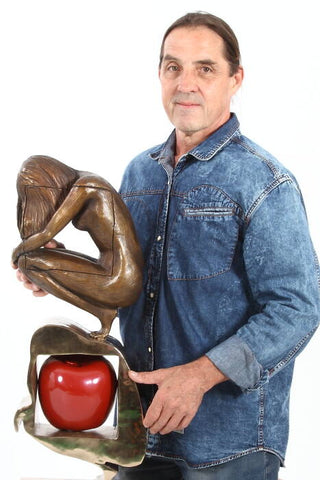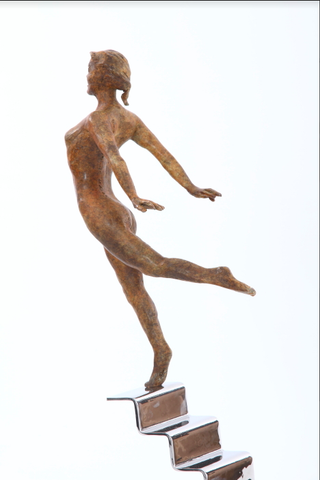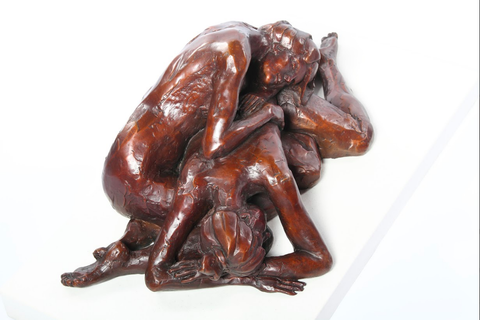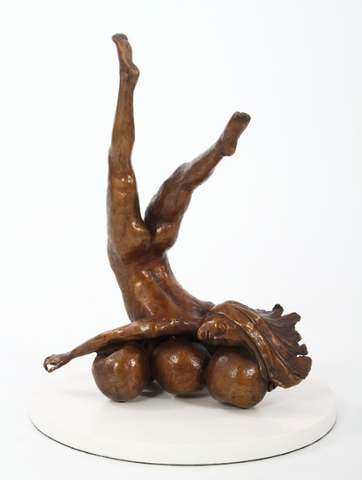Written by Briony Haynes BA (Hons) History of Art and English Literature

Marke Meyer is most notably known for creating bronze sculptures that depict free-spirited, carefree young women that visually embody his written poetry. Meyer’s poetry and artwork is often associated to a series of underlying themes including the ideas of finding balance in life and living in harmony with oneself. His sculptures encapsulate a peaceful serenity in the way they gracefully suspend from the ceiling or appear to be balanced precariously on ledges in acts of confidence, freedom and equilibrium. (Fig.1)


Meyer often states that he is fascinated by the Old Masters sculptors’ grand attempts at using three dimensional space in intricate, twisting compositions. He uses this interest to his advantage by contorting the figures in his own works to produce visually enticing forms. When evaluating the works of these great sculptors’ such as Bernini and perhaps more predominantly Giambologna, interesting parallels can be depicted between their works and Meyers bronzes. For example, Meyers ‘Chocolate and Sushi’ (Fig.3) achieves an interest in shape and angles while also displaying a textured, feminie grace and beauty, similar to what is achieved by Giambologna in his ‘Rape of the Sabine Woman’ (Fig.2). By evaluating the composition of Meyer’s work alongside the Old Masters it can be seen how classical movement, curves, shape and form have been a prominent factor in influencing Meyer’s work.




Not only does Meyer’s work reference back to the late 16th Century but he simultaneously looks forward to contemporary artists to achieve compositional tension in his figures and to develop themes. By looking at the thoughts behind Meyer’s work such as the idea of childhood freedom and staying young and fearless, it can be seen that he balances this aspect with a sophisticated, adult nature in the nude womanly figures he is using. His work is about balance, and the balance between two opposing aspects of life that must live harmoniously. This can be likened to one of his contemporaries Willy Verginer who Meyer admires (Fig.3). Verginer similarly portrays a balance between aspects of life but contrastingly between humans and nature. Although a different thematic idea is being expressed both artists look to create a distinction between two opposing factors, adulthood and childhood, man and nature, good and bad. Verginer creates more of an exact defining split which makes his work visually striking whereas Meyer looks to find unity and causes tension through visual balance and beauty.




This vast knowledge of art history and techniques that Meyer has acquired over time was not achieved through academic study but rather through desire and trial. Meyer was introduced to art by his girlfriend while he was studying for a BSc in Agriculture. This encouraged him to take up painting and drawing and inspired an avid interest in collecting art books. Through this collection of material Meyer slowly taught himself everything from art history to techniques, perhaps an insight into his wide breadth of inspiration.
Meyer’s artistic talent was further influenced by his poetry background which began during his youth as he spent much of his time reading the dramatized philosophical works of Ayn Rand. Rand was a philosophical American-Russian writer who coined the term Objectivism, a process that can be strongly linked to Meyer’s work. Objectivism is defined as "the concept of man as a heroic being, with his own happiness as the moral purpose of his life, with productive achievement as his noblest activity, and reason as his only absolute.'' By looking at Meyer’s ‘Your Breath, Your Thoughts and Your Tempered Dream’ it is evident that he too expressed these ideas of happiness directing purpose through his childhood imagery and dreamlike compositions.

Meyer’s artwork leans into a semi-naïve, fantastical, conceptual world of his own imagination and experience. He often states that he sculpts his dreams, perhaps once again suggesting the reflection of the whimsical, floating nature of his works. There is however a collection of recurring iconography that Meyer often refers to, these include the likes of apples, chameleons and chairs. By working as a poet, Meyer has often seen the value of a metaphor in his written work which can be seen to have naturally carried through in his visual poetry, his artworks. These icons or metaphors that point to a deeper or a more hidden truth are employed in his work through a series of ways both symbolically, as whole pieces or as components.
Childhood development and outside influences on character formation, informs much of Meyer’s work. As such using items like an apple to be either the ‘Teachers’ apple or the temptresses ‘Eve’s’ apple (Fig.7). Similarly, the use of chairs indicates growing-up through various important developmental stages and Chameleons are used to communicate concepts like self-preservation, adaptation and the attempt at ‘fitting-in’. Chameleons can also be seen as a metaphor for the hidden-self.




By continually using these iconographic aspects Meyer has managed to create a body of work that echoes this idea of the hidden-self, a free and confident self. Meyer’s upcoming exhibition ‘Beneath the Surface’ refers to all the things about an individual that remain hidden from view and yet constitute the true identity of the person. At times an unsuspecting person may be offered a glimpse into some of these traits and this exhibition hopes to spread light onto these hidden truths.
